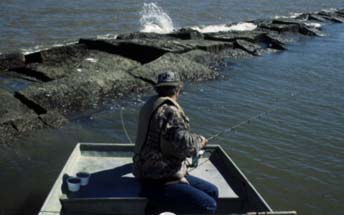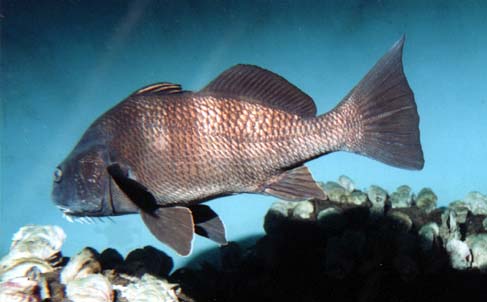
The Saltwater Magazine for Gulf Coast Fishing!
Drifting for Drum
by Chester Moore, Jr.
SPRING ISSUE 2003



- Michelangelo could not have painted a more beautiful scene...
A young boy with his rod doubled over sported a magnificent grin as he and his father drifted over Hannah's Reef on Galveston Bay. While anglers around them unsuccessfully grinded out a windy April afternoon in search of speckled trout, this youngster hit the jackpot in a big way.

On the end of his line was a 30-pound black drum and although it was not what he set out to catch, the boy could not have been happier.
That boy was me and although that happened more than 20 years ago, the memory of my first encounter with a huge black drum is forever burned in my memory. These days I spend more time pursuing speckled trout, flounder and redfish, but I must admit, I always save a little time for black drum, especially the big ones.
During the month of April, big black drum beat their way into bay systems and converge on oyster reefs. Many anglers target them by fishing from the bank along ship channels and at man-made structure like the Texas City Dike. There is another way to catch drum, however, and that involves drifting with boats.
Oyster reefs are unique ecosystems. In open, barren bays, they are like an oasis in the desert. Reefs are great spots for small baitfish to seek refuge and to prey on micro-organisms. In addition, they draw in lots of drum in the spring.
My tactic for catching drum involves drifting lead jigheads tipped with big table shrimp or pieces of crab.
The most crucial part of this technique is to use a heavy jig head. Fishing with 1/8 and 1/4-ounce jig heads may be fine for chasing trout in other areas but on reefs you need something that will get down to the bottom and be able to fight heavy spring currents. I would go with at least a 3/8-ounce jighead, but actually prefer a 1/2-ounce head. Drift with the current and let the jig bounce, bump and crash into the oyster reef. Water conditions during spring usually range from off-colored to murky to just plain nasty, so anything that might grab the attention of a drum is worth trying.
Not all oyster reefs are equal and not all parts of an oyster reef are the same. It is important to look for the structure within structure.
Fish Structure
An oyster reef is a structure all by itself, but there is structure on top of that structure. A big clump of oysters rising up on a slight ridge on a reef with an average depth of 10 feet is structure on structure. A sunken boat on a reef is structure on structure.

Locating drop-offs is very important to locating drum on reefs. A ledge that drops off to 16 feet on a 10 feet deep reef is a necessary fishing spot. Drum will stack up in these places.
Anglers should let out some extra line over these spots to make sure they reach the fish. If you just jump over these spots without letting some extra line out, you may not reach the fish. Keep your electronics on and look for the drop-off. When you hit it let out some extra line and you will probably catch some fish.
An indispensable tool in reef fishing is a marker buoy. You can purchase these buoys at a tackle store or simply make your own with two-liter cola bottles.
When coming across a hot spot throw out the buoys so you can return there. There might be 50 big, bruiser drum bunched up in a 20-yard spot and that may be where they stay all day. It is important to be able to stay within the bite window to be successful.
If you are fortunate enough to locate a spot that is loaded with big drum you might want to consider anchoring and breaking out the ultra-light tackle.
I sometimes use a medium action spinning rod rigged with Berkley Fireline in the six pound diameter, 10 pound test class. I put on a round 3/8 ounce jig head and tip it with shrimp then drop it off the side of the boat. The braided line is extremely sensitive and allows me to feel the tiniest peck on a bait. As soon as I feel anything, I set the hook and get rewarded (or punished) with a drum.
If you do not like fishing with braided line you might want to watch your line instead of waiting to feel a bite. If you see any twitching in the line set the hook because you most likely have a fish on.
Another good way to catch drum is to fish a big hunk of crab on the bottom. Something to keep in mind is that these fish are not shy. If you have not had action within a few minutes after dropping a bait in one particular hole, move to another. They usually hit either right away or not at all.
Black drum and jetties go hand in hand. Jetties offer a virtual buffet of blue crabs and other crustaceans, which drum feed on almost exclusively.
Years ago, veteran angler Joe Persohn taught me that the largest concentrations of drum seem to be at the deep holes at the southern tip of the Gulf side of jetties. These areas are especially important during the period between March and early June when the big bull drum are hanging around as they may serve as staging points.
"If you can't get to the deep holes for some reason back off and look for dips in the rocks," Persohn said.
"These dips indicate deep holes and that's where the drum will be. Another sign to be on the look out for is vegetation growing on the bottom of the rocks. These areas hold lots of small crabs which drum feed on," he added.
Like Persohn, I prefer to fish for drum with light tackle, in the 15 to 17- pound class.
I use blue crab broken in half and hooked through the carapace. Crab lasts awhile on the hook whereas sheepshead and hardheads will gobble up shrimp around jetties in the spring.
The usual drill involves putting out several lines with a slip egg weight above the swivel, finished off with a wide gapped hook. This simple set up is ideal for catching them, but knowing when to set the hook is another issue entirely.
Drum like to peck on bait. They do not always take off with it like other fish, so the best thing to do is to set the rod in a holder and turn on the clicker. When the clicker starts to sound, turn off the clicker and reel in the slack. When it feels like your rod is water bound, set the hook.
This is quite a paradox because the drum caught drifting in the bay slam the jig tipped with shrimp with great fury.
Drum are strong fighters although not in the same way as a redfish which makes quick runs or a trout that leaps into the air. They are simply, determined to fight hard and long.
Take the case of Herb York of Buna, Texas, for example. York was fishing for drum in Galveston Bay and thought he had hooked into a monster drum. The line alarm on his reel sounded off and kept going at a steady pace. Certainly this was a big drum, the kind he has been fishing for all day.
After 30 minutes of battle he reeled up an old truck tire someone had discarded in the bay.
"I sat there kind of embarrassed I had battled this tire for so long, but then again how could I know. When I got to thinking about it a bull drum on the end of a line kind of feels like a tire drifting in the current," he said.
The fight may not dazzle, but it will certainly wear you out.